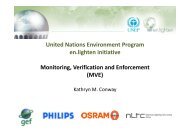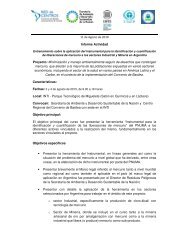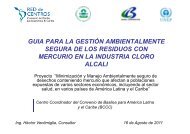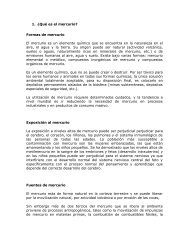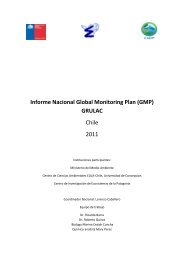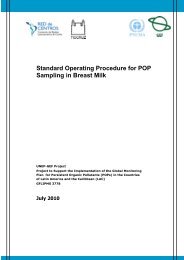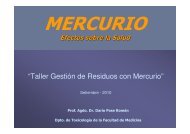Report on Global Monitoring Project Pesticide Research Laboratory ...
Report on Global Monitoring Project Pesticide Research Laboratory ...
Report on Global Monitoring Project Pesticide Research Laboratory ...
You also want an ePaper? Increase the reach of your titles
YUMPU automatically turns print PDFs into web optimized ePapers that Google loves.
Table 1<br />
Installati<strong>on</strong> date<br />
**August 26,<br />
2010<br />
Sampling<br />
Time<br />
Round<br />
Number<br />
PUF samples<br />
analysed by<br />
Spain<br />
PUF samples<br />
analysed by<br />
PRL<br />
9:24 am 1 1, 2, 5 and 7 3, 4, 6, 8 and (the<br />
“reserve” was<br />
analysed by<br />
Bennin)<br />
October 1, 2010 12:20 pm – 12:57<br />
pm<br />
2 1, 2, 5 and 6 3, 4, 7, 8 and<br />
“reserve”<br />
January 3, 2011 5:26 pm – 6:02 pm 3 1, 2, 5 and 6 3, 4, 7, 8 and<br />
“reserve”<br />
April 8, 2011 3:45 pm – 4:30 pm 4 1, 2, 5 and 6 3, 4, 7, 8 and<br />
“reserve”<br />
** Due to late arrival of the PUFs from Spain, the first exposure of the PUFs was not d<strong>on</strong>e as<br />
proposed. (The proposed date was July 1, 2010). So, the first round of samples was <strong>on</strong>ly<br />
exposed for <strong>on</strong>e (1) m<strong>on</strong>th instead of three (3) m<strong>on</strong>ths.<br />
The final round of PUF exposure ended <strong>on</strong> July 8, 2011 between 3:30 pm and 3:45 pm .<br />
Secti<strong>on</strong> 2<br />
Standard Operating Procedure (SOP) for the extracti<strong>on</strong> of PUF sample by the Soxhlet<br />
Method<br />
A pair of clean scissors was used to cut the PUF into small pieces (about 1 cm 2 ) which then<br />
placed into the Soxhlet Apparatus (no thimble was used) with the aid of a pair of tweezers and a<br />
glass stirring rod.<br />
About 200 mL of toluene were added to a 500 mL round bottom flask. (This amount of toluene<br />
was added so that when the extracti<strong>on</strong> tube was filled to the siph<strong>on</strong> point, there was enough<br />
solvent left in the flask to prevent cracking due to heating). The extracti<strong>on</strong> apparatus was<br />
assembled, the round bottom flask positi<strong>on</strong>ed in the heating mantle and the water flow started<br />
through the c<strong>on</strong>denser. The apparatus was supported using a clamp and stand. The heat was<br />
adjusted for at least six cycles per hour. (The cycle is the filling of the extracti<strong>on</strong> tube with<br />
solvent which evaporates from the flask and then c<strong>on</strong>denses into the tube, followed by siph<strong>on</strong>ing<br />
of solvent back into the flask). The sample was extracted for ten (10) hours. The extract was<br />
c<strong>on</strong>centrated to about 1 mL using a rotary evaporator. The 1 mL of evaporated sample extract<br />
was transferred to a florisil column which was prepared as follows: 25 cm x 1 cm glass column<br />
(with a Tefl<strong>on</strong> stopcock and 250 mL reservoir) was plugged with 2 cm glass wool, filled with


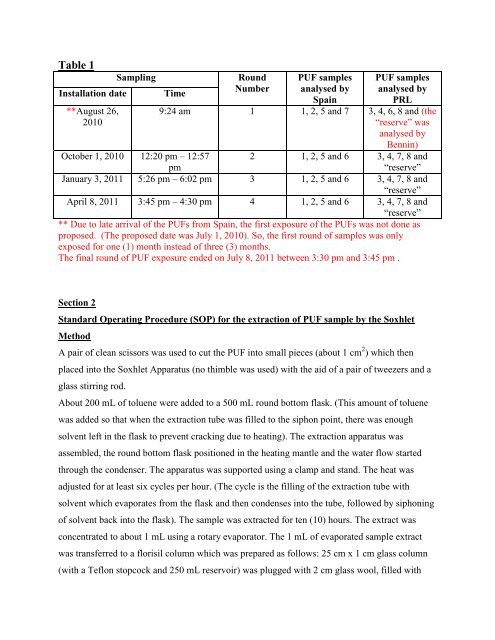


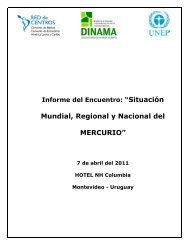
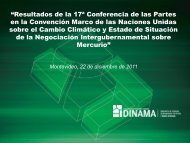

![COP_aire [Compatibility Mode] - Centro Coordinador de Basilea ...](https://img.yumpu.com/44106171/1/190x134/cop-aire-compatibility-mode-centro-coordinador-de-basilea-.jpg?quality=85)
